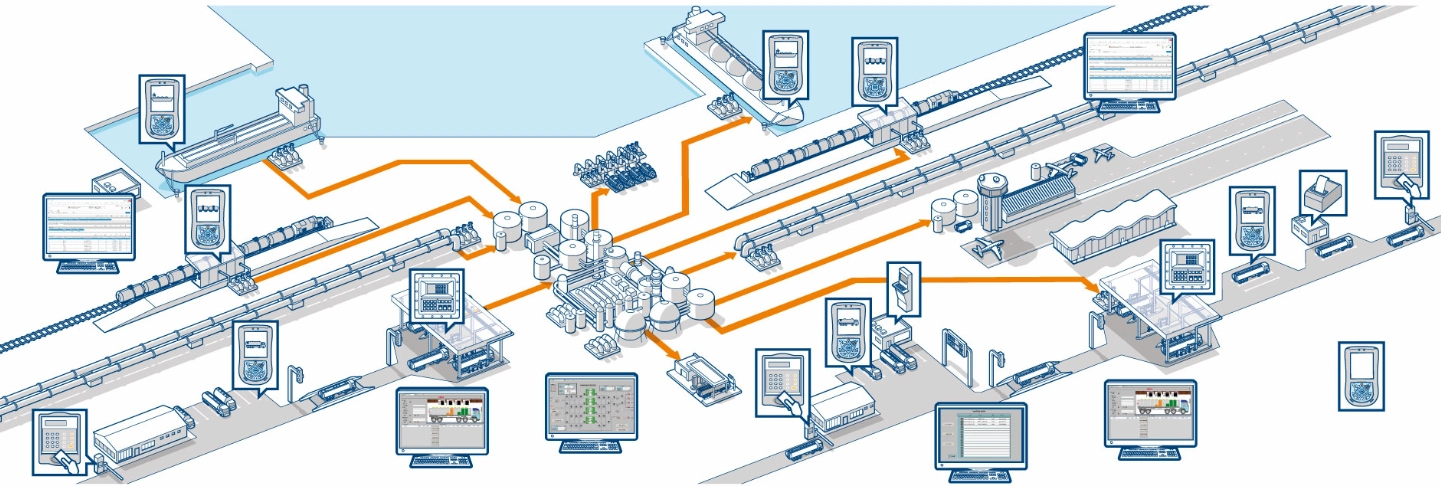ABB Ability™ System T-MAC Plus is highly scalable and offers more functional modules than any other vendor in the market. These modules can be combined to meet the customer’s specific needs.
It manages inventory, receipt, and dispatch of products by trucks, barges, railcar, pipeline, and aviation.
Modules
The Base System includes common functionality like:
- order entry and visit inspection,
- automatic Bill of Lading (BOL) generation and printing,
- basic reporting including daily loading report, daily products delivery, daily average loading time, order listing,
- graphic displays such as plant overview, tank farm, loading/unloading bays overview.
In the Receipt/Dispatch by trucks as an example, the system controls and monitors:
- loading and unloading operations including order verification,
- identification of the truck, trailer, and driver at the loading bay,
- communication with the electronic preset,
- monitoring of the physical interlocks (grounding, overfill protection, vapor recovery arm position, and loading arm position),
- generation and printing of the BOL and other required documents,
- calculation of quantities of solid or heavy products via weighbridge.
Other important functionality is listed below:
- Access control: it allows the trucks to enter and exit the terminal, ensuring security by validating driver access through card readers and/or scanners.
- Inspections: for safety and security reasons, a certain number of physical checks of vehicles (trucks, trailers, rail wagons, or barges) are required as part of the terminal’s procedures.
- Kiosk functionality: with this module, it is possible for the driver to prepare the loading/unloading before going to the loading bay, saving time.
- Automatic bay/berth allocation: this module expedites terminal operations with intelligent vehicle management and informs the truck driver of the most suitable loading bay for the selected order according to product and bay availability.
- Sealing: this module manages the seal associated with each compartment of the truck after the loading process.
- Blending in loading arm: it manages the mix of different products stored in the terminal to generate a new product during the dispatch process. The module includes up to 10 recipes.
- Blending in tank/in line: this module manages the blending process in a tank by automatically using product movements between tanks or in line by blending during the product receipt process. The module includes up to 10 recipes.
- Additive in loading arm: this module manages the additive process in loading arm during the product dispatch process. The module includes up to 10 recipes and up to 5 additives.
- Additive in tank/in line: this module manages the additive process during the product receipt process. The module includes up to 10 recipes and up to 5 additives.
- Automatic tank farm control: it integrates with the Tank Gauging System (TGS) to obtain information about temperature, net volume, gross volume, level, and more to calculate product inventory, balance, and stock reconciliation.
- Self-consuming: this module measures products consumed for use inside the terminal like for example heating, diesel pumps, or fuel for vehicles that operate in the terminal.
- Product balance: this module performs the following tasks: product/additive inventory measuring the products stored in the terminal, product/additive balance calculating the theoretical product quantity based on all operations, and finally product/additive reconciliation calculating the product/additive gains and losses.
- Multi-operator management: this module is useful when the same terminal facility is used by multiple product owners and an accurate inventory and balance is required.
- Movements scheduling: this module manages the movement operations in the terminal facility. All inter-tank transfer operations, product receipt, or product dispatch orders are managed by the system and shown in a Gantt chart to help the operator improve efficiency of the terminal.
- Handheld functionality: it allows the operator to use a handheld device to perform manual tasks such as inspection, sealing, etc. The handheld device may be connected to the system via Wi-Fi (online mode) or store the information internally and download it to the system at a later stage (offline mode).
Project specific functionality includes:
- ERP integration,
- Additional functionality.

Terminal Insight App
The App links the different stakeholders around the terminal by assigning different roles: product owner, hauler, driver, terminal manager, terminal operator, and gas station manager. Each of these roles will have different capabilities and options when accessing the App.
Some of the advantages for the driver are:
- no need for dedicated identification devices,
- completely paperless process with no need to stop and print BOL,
- improved documentation process where driver, truck, and trailer documentation are automatically uploaded from the App,
- support through smartphone with no need for any specific communication devices.


